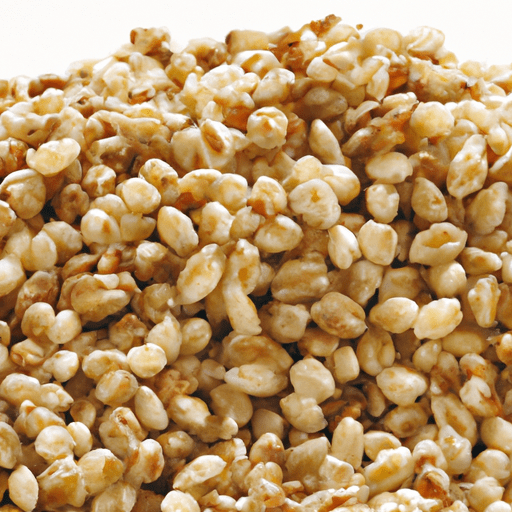The Delightful Cooked Grain Blend: A Perfect Addition to Your Culinary Repertoire
If you’re looking to elevate your meals with a nutritious and flavorful twist, look no further than a cooked grain blend. This versatile combination of various grains strikes the perfect balance of taste, texture, and nutritional value. Whether you’re a committed foodie or a busy home cook, the cooked grain blend is here to offer a world of culinary possibilities.
A Symphony of Flavors and Textures
Cooked grain blends often consist of a harmonious medley of grains such as quinoa, brown rice, wild rice, barley, and farro. This diverse mixture not only adds depth to your dishes but also invites an array of textures to tantalize your taste buds. Indulge in the fluffy and delicate nature of quinoa, the satisfying chewiness of barley, and the nutty essence of brown rice.
Wide Range of Culinary Applications
The beauty of cooked grain blends lies in their versatility. From hearty salads and scrumptious side dishes to wholesome main courses, this grain amalgamation effortlessly enhances any meal. Toss it with fresh vegetables, herbs, and a zesty dressing for a vibrant grain salad bursting with flavor. Alternatively, use it as a bed for roasted vegetables, grilled protein, or sautéed mushrooms for a delightful main course. The possibilities are endless – let your culinary creativity soar!
Nutritional Powerhouse
In addition to their remarkable taste and texture, cooked grain blends boast an impressive nutritional profile. Packed with essential vitamins, minerals, and dietary fiber, these grains provide a wholesome and nourishing addition to your diet. The combination of grains ensures a well-rounded blend of nutrients, making it an excellent choice for those seeking a balanced meal. From supporting digestion to promoting heart health, the nutritional benefits of cooked grain blends are simply remarkable.
Beyond the Plate: A Dash of History and Fascinating Facts
Cooked grain blends have a rich history rooted in various culinary traditions. Ancient civilizations relied on these grain medleys as a staple food source due to their longevity, versatility, and nutritional value. The Egyptians savored a mixture called “kushari,” blending lentils, rice, and macaroni, while the Aztecs treasured amaranth, quinoa, and maize mixtures.
Interestingly, the cooked grain blend has also gained popularity in recent years as a grain-based alternative to meat. With its impressive texture and nutritional profile, grain blends have become a favorite among plant-based enthusiasts, offering a satiating alternative in a world of innovative meat substitutes.
A Journey Worth Embarking On
In conclusion, the cooked grain blend is an exceptional addition to any kitchen. Its combination of tantalizing flavors, versatile applications, and remarkable nutritional benefits make it a must-have ingredient for food lovers and health-conscious individuals alike. Whether you’re experimenting with new recipes or aiming to enhance old favorites, this grain blend will take your cooking to new heights. So, embark on this culinary adventure and savor the wonders of a cooked grain blend – your taste buds and body will thank you.
Note: Images source: Unsplash
Cooked Grain Blend
Origin: Cooked grain blend is a versatile mixture of different grains that are cooked together to create a nutritious and flavorful base. While the specific origin of cooked grain blends is challenging to trace, the concept of combining various grains has been practiced throughout history in different cultures around the world.
Common Uses: Cooked grain blends are used in a variety of dishes and cuisines. They can be served as a side dish alongside proteins such as roasted vegetables, chicken, or fish. They are also commonly used as a base for grain bowls, salads, pilafs, and stir-fries. Cooked grain blends can add texture, flavor, and nutritional value to a wide range of recipes.
Nutritional Benefits: Cooked grain blends offer several nutritional benefits due to the combination of different grains. They are excellent sources of complex carbohydrates, dietary fiber, and provide sustained energy. The specific nutrient content can vary depending on the grains used in the blend. However, generally, these blends can provide essential vitamins, minerals, and antioxidants, making them a healthy addition to a balanced diet.
Unique Properties: One of the unique properties of cooked grain blends is the combination of different grains, which results in an amalgamation of flavors, textures, and colors. By mixing grains such as quinoa, brown rice, barley, wild rice, or farro, the resulting blend can offer a delightful medley of tastes and appearances. This diversity in flavors and textures enhances the overall enjoyment of the dish.
Historical Significance: The concept of combining multiple grains in cooking has historical significance. In many cultures, the practice of blending grains was born out of necessity, as it allowed people to make the most of available resources and create meals that were both filling and nutritious. Nowadays, cooked grain blends continue to be a popular choice, reflecting the creative and resourceful nature of cooking.




Use the share button below if you liked it.
It makes me smile, when I see it.